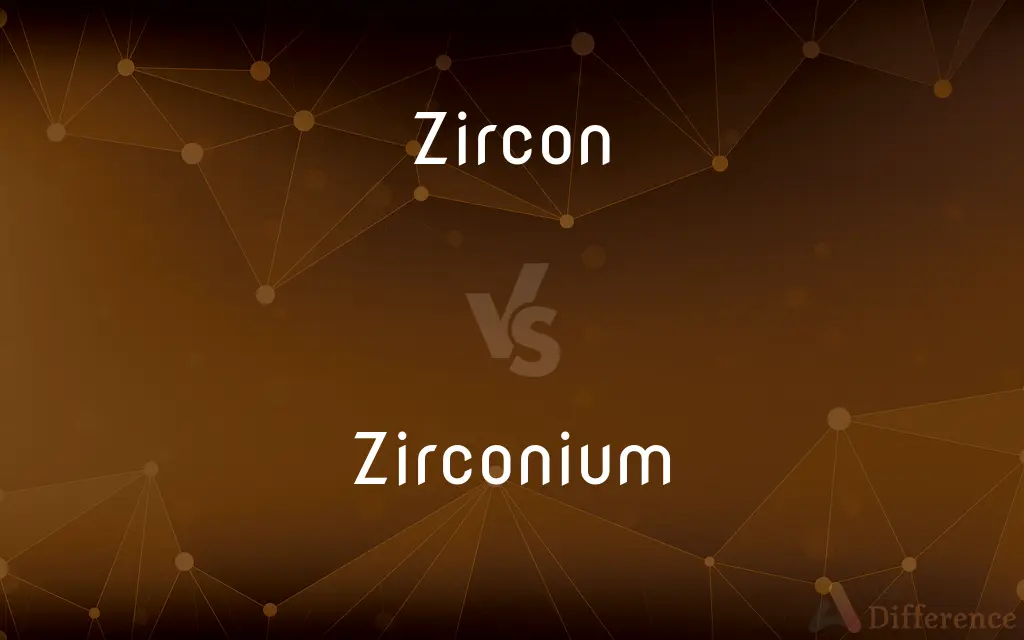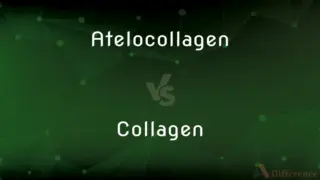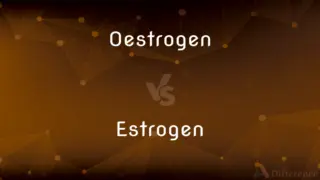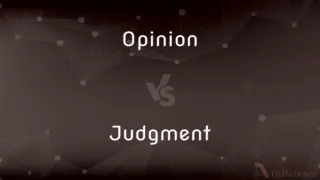Zircon vs. Zirconium — What's the Difference?
By Urooj Arif & Fiza Rafique — Updated on April 4, 2024
Zircon is a gemstone, while zirconium is a metallic element used in various industries.

Difference Between Zircon and Zirconium
Table of Contents
ADVERTISEMENT
Key Differences
Zircon, a natural mineral, is best known for its use as a gemstone in jewelry, offering a range of colors from clear to vibrant blues and greens. Whereas zirconium, a chemical element with the symbol Zr and atomic number 40, is a lustrous, grey-white, strong transition metal that is used in various industrial applications, including as an alloying agent in materials that are exposed to corrosive agents.
Zircon is valued for its brilliance and fire, characteristics that make it a popular substitute for diamonds and other precious gemstones. On the other hand, zirconium's corrosion resistance makes it ideal for use in dental implants, nuclear reactors, and even in the space industry, highlighting its versatility beyond the jewelry industry.
The extraction and refinement processes for zircon and zirconium differ significantly. Zircon is mined from silicate mineral deposits and is often heat-treated to enhance its color and clarity. Zirconium, however, is typically obtained from zircon through a complex process of mining the mineral, then separating zirconium from zirconium silicate, followed by a series of chemical reactions to produce the pure metal.
Despite their similar names, zircon and zirconium serve vastly different purposes. Zircon's primary appeal lies in its aesthetic value and use in fashion and decoration, while zirconium is prized for its physical and chemical properties that lend themselves to practical applications in engineering and technology.
Both zircon and zirconium highlight the diverse applications of elements and compounds derived from the earth. While zircon enchants with its beauty and versatility as a gemstone, zirconium contributes to technological advancements and the functionality of many modern materials.
ADVERTISEMENT
Comparison Chart
Nature
Gemstone
Metallic element
Uses
Jewelry, decorative items
Alloys, nuclear reactors, dental implants
Properties
Brilliance, variety of colors
Corrosion resistance, high melting point
Extraction/Production
Mined as zircon mineral, heat-treated
Extracted from zircon mineral, chemically separated
Value
Aesthetic and gemological
Industrial and technological
Compare with Definitions
Zircon
A mineral belonging to the group of nesosilicates.
The jeweler showcased a stunning piece of blue zircon in the display.
Zirconium
Used to make corrosion-resistant alloys.
The reactor's core was made of a zirconium alloy to withstand high temperatures.
Zircon
Used as a gemstone, often as a diamond substitute.
She opted for a zircon ring, attracted by its dazzling appearance.
Zirconium
Essential in nuclear energy due to its low neutron-absorption rate.
Zirconium tubes are used in nuclear reactors to encase fuel.
Zircon
Available in a range of colors due to various impurities.
The variety of zircon colors, from red to green, amazed the collectors.
Zirconium
A chemical element with symbol Zr and atomic number 40.
Zirconium is widely used in the aerospace industry for its strength.
Zircon
Often heat-treated to enhance color and clarity.
The heat-treated zircon displayed a deeper blue hue.
Zirconium
Found in many everyday products like antiperspirants and coatings.
Zirconium compounds are used in deodorants for their effectiveness.
Zircon
Known for its high refractive index and strong dispersion.
The zircon's brilliance outshone many other stones in the collection.
Zirconium
Extracted from zircon through complex chemical processes.
The extraction of zirconium from zircon requires high temperatures.
Zircon
Zircon ( or ) is a mineral belonging to the group of nesosilicates and is a source of the metal zirconium. Its chemical name is zirconium silicate, and its corresponding chemical formula is ZrSiO4.
Zirconium
A lustrous, grayish-white, strong, ductile metallic element obtained primarily from zircon and used in nuclear reactors because of its high resistance to corrosion, used in ceramic and refractory compounds, and alloyed with niobium, zinc, and other metals. Atomic number 40; atomic weight 91.22; melting point 1,855°C; boiling point 4,409°C; specific gravity 6.52 (at 20°C); valence 2, 3, 4. See Periodic Table.
Zircon
A brown to colorless mineral, ZrSiO4, which is heated, cut, and polished to form a brilliant blue-white gem.
Zirconium
Zirconium is a chemical element with the symbol Zr and atomic number 40. The name zirconium is taken from the name of the mineral zircon (the word is related to Persian zargun (zircon; zar-gun, "gold-like" or "as gold")), the most important source of zirconium.
Zircon
(uncountable) A mineral occurring in tetragonal crystals, usually of a brown or grey colour and consisting of silica and zirconia.
Zirconium
A chemical element (symbol Zr) with an atomic number of 40, a strong, lustrous, grey-white transition metal mainly used as a refractory and opacifier.
Zircon
(countable) A crystal of zircon, sometimes used as a false gemstone.
Zirconium
A rare element of the carbon-silicon group, intermediate between the metals and nonmetals, obtained from the mineral zircon as a dark sooty powder, or as a gray metallic crystalline substance. Symbol Zr. Atomic weight, 90.4.
Zircon
A mineral consisting predominantly of zirconium silicate (Zr2SiO4) occurring in tetragonal crystals, usually of a brown or gray color. It consists of silica and zirconia. A red variety, used as a gem, is called hyacinth. Colorless, pale-yellow or smoky-brown varieties from Ceylon are called jargon.
Zirconium
A lustrous gray strong metallic element resembling titanium; it is used in nuclear reactors as a neutron absorber; it occurs in baddeleyite but is obtained chiefly from zircon
Zircon
An imitation gemstone made of cubic zirconia.
Zircon
A common mineral occurring in small crystals; chief source of zirconium; used as a refractory when opaque and as a gem when transparent
Common Curiosities
How is zirconium different from zircon?
Zirconium is a metallic element used in various industrial applications for its physical and chemical properties, while zircon is a gemstone known for its visual qualities.
Can zircon be used in technology?
While zircon's main applications are in jewelry and decoration, its derivatives, especially zirconium, play significant roles in technology and industry.
Is zirconium found in its pure form in nature?
Zirconium is not found in its pure form in nature; it is extracted and purified from minerals like zircon through chemical processes.
Why is zirconium important in nuclear reactors?
Zirconium is crucial in nuclear reactors because of its low neutron-absorption rate and high resistance to corrosion, making it ideal for encasing fuel rods.
Can zirconium be used in jewelry?
Zirconium itself is not typically used in jewelry, but zircon, the gemstone, is. Zirconium can be processed into cubic zirconia, a synthetic gemstone.
What is zircon used for?
Zircon is primarily used as a gemstone in jewelry and decorative items due to its aesthetic appeal and range of colors.
What are the common uses of zirconium in everyday life?
Zirconium is used in various everyday products, including as an alloy in medical implants, in antiperspirants, and in protective coatings.
How are zircon and zirconium related?
Zirconium is extracted from zircon, the mineral. While they share a chemical component, their uses and properties differ greatly.
Are all zircon stones heat-treated?
Not all, but many zircon stones are heat-treated to enhance their color and clarity, making them more appealing for use in jewelry.
What makes zircon a popular gemstone?
Zircon's popularity as a gemstone comes from its brilliance, fire, and range of colors, making it a versatile and attractive choice for jewelry.
Share Your Discovery

Previous Comparison
Beautiful vs. Exceptional
Next Comparison
Atelocollagen vs. CollagenAuthor Spotlight
Written by
Urooj ArifUrooj is a skilled content writer at Ask Difference, known for her exceptional ability to simplify complex topics into engaging and informative content. With a passion for research and a flair for clear, concise writing, she consistently delivers articles that resonate with our diverse audience.
Co-written by
Fiza RafiqueFiza Rafique is a skilled content writer at AskDifference.com, where she meticulously refines and enhances written pieces. Drawing from her vast editorial expertise, Fiza ensures clarity, accuracy, and precision in every article. Passionate about language, she continually seeks to elevate the quality of content for readers worldwide.
















































